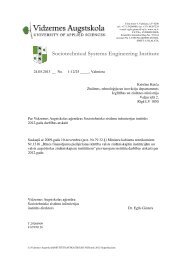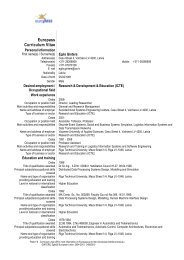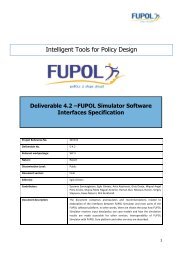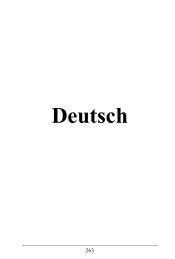DUAL SUBSTITUTION METHOD OF SOLVING PARTIAL DIFFERENTIAL EQUATIONSValerijs StepuchevsLatvian Intelligent <strong>Systems</strong>, Ltd., Sigulda, LatviaE-mail: valerijs@lis.lvKEYWORDSPartial differential equations, Dual substitution,Special functions.ABSTRACTAlready for more than 300 years greatmathematicians f<strong>in</strong>d and study different specialfunctions. The majorities of these special functions arethe solutions of the differential equations, which areobta<strong>in</strong>ed as a result of separation of variables <strong>in</strong> theequations of mathematical physics. In the article thenew simple method of solv<strong>in</strong>g the partial differentialequations is proposed, and as a result, another methodof the solution of new special functions from theequations of mathematical physics. In this method,there is no stage of separation of variables dur<strong>in</strong>g thesolution of equation, and this means that thedeterm<strong>in</strong>ed one-dimensional special functions havenature that is more general. In the article, Helmholtz'sequation is described as an example, and it is knownthat this equation is widely used for solutions of tasksconnected with the steady fluctuations (mechanical,acoustic, thermal, electromagnetic, etc.). It is a currentissue to f<strong>in</strong>d the optimal solution of all these tasks,which can be f<strong>in</strong>d the way allowed for traditional ICTEresources.SOLUTION OF TWO-DIMENSIONALDIFFERENTIAL EQUATION OF LAPLACELet us exam<strong>in</strong>e equation:2 2∂ u ∂ u+ = 02 2 (1)∂x∂ ywhere x and y – the <strong>in</strong>dependent variables,u( x, y ) – the analytic function from x and y .In (Полянин 2001) the quite general method ofconstruct<strong>in</strong>g the exact solutions through the analyticcomplex variable functions is given. In this article, asimplest method will be shown for the obta<strong>in</strong><strong>in</strong>g of thecomplete set of the analytic functions.An equation is given (1) and it is given, that <strong>in</strong>tosome region the solution G takes form∑∑∞ ∞i ju ( x,y)= ai,jx y(2).i=0 j=0Let us make substitution of this solution (2) <strong>in</strong>todifferential equation (1) (this is the first substitution).Compar<strong>in</strong>g coefficients with the identical degrees, the<strong>in</strong>f<strong>in</strong>ite system of equations will be obta<strong>in</strong>ed for theacoefficients i,j (this is a familiar procedure, but thisis only the first step):⎛ 2a2,0 + 2a0,2= 0⎞⎜⎟⎜6a3,0 + 2a1,2= 0⎟⎜...⎟ .⎜⎟⎜( i + 1)( i + 2) ai+ 2, j+ ( j + 1)( j + 2) ai, j+2= 0⎟⎜...⎟⎝⎠Then the system can be written as follows (thegroup of the coefficients of those correspond<strong>in</strong>g for thedifferential equation ai + 2 , j is expressed throughthe group of free coefficients a 0 , j and a 1 , j ):⎛ a⎜⎜ a⎜⎜⎜...⎜⎜ a⎜⎝...= −a2,0 0,21= − a33,0 1,2( j + 1)( j + 2)= −a( i + 1)( i + 2)i + 2, j i, j + 2Several equations will be written to understandfurther actions better:⎞⎟⎟⎟⎟⎟⎟⎟⎟⎠.Annual <strong>Proceed<strong>in</strong>gs</strong> of Vidzeme University College “ICTE <strong>in</strong> Regional Development”, 2006130
aaaaa6= −aa2,1 = − a0,3226= − a a3,1 = − a1,36626= − a a4,1 = − a2,3121226= − a a5,1 = − a3,3202026= − a a6,1 = − a4,330302,0 0,23,0 1,24,0 2,25,0 3,26,0 4,2- - - - - - - - - - - - - - - - - - - - - - - - - - - - - - - - - - - - -aaaaa1220= − a a2,3 = − a0,5221220= − a a3,3 = − a1,5661220= − a a4,3 = − a2,512121220= − a a5,3 = − a3,520201220= − a a6,3 = − a4,530302,2 0,43,2 1,44,2 2,45,2 3,46,2 4,4- - - - - - - - - - - - - - - - - - - - - - - - - - - - - - - - - - - - -Let us replace the known variables (known - <strong>in</strong> thesense of the exist<strong>in</strong>g expression for them through thefree variables) <strong>in</strong> the equations, where they are usedrepeatedly, to their expressions.2 12a4,0 = − ( − a0,4)= a0,412 22 12 1a5,0 = − ( − a1,4 ) == a1,420 6 52 12 30a = − ( − ( − a )) = −a30 12 26,0 0,6 0,6- - - - - - - - - - - - - - - - - - - - - - - - - - - - - - - - - - - - -a6 20= − ( − a12 2) = 5aa12 30= − ( − a12 2) = 15a4,1 0,5 0,54,2 0,6 0,6- - - - - - - - - - - - - - - - - - - - - - - - - - - - - - - - - - - - -6 20a = − ( − a ) = a20 65,1 1,5 1,5- - - - - - - - - - - - - - - - - - - - - - - - - - - - - - - - - - - - -Thus all coefficients ai + 2 , j can be expressedthrough the free coefficients a 0 , j and a 1 , j .Further the second substitution will be made - let ussubstitute the obta<strong>in</strong>ed expressions for the coefficientsai + 2 , j <strong>in</strong>to solution of (2)∑∑∞ ∞i ju ( x,y)= ai,jxy.i=0 j=0Afterwards the follow<strong>in</strong>g solution of the equation isobta<strong>in</strong>ed:u( x, y)= a + a x + a y − a x + a xy + a y −2 20,0 1,0 0,1 0,2 1,1 0,21 3 2 2 3 4 3 2 2− a1,2 x − 3a0,3x y + a1,2 xy + a0,3 y + a0,4x − a1,3 x y − 6a0,4x y +33 4 15 4 3 2+ a1 , 3x y + a0 , 4y + a1 , 4x + 5 a0 , 5x y − 2 a1 , 4x y −52 3 4 5 6 5− 1 0 a x y + a x y + a y − a x + a x y +0 , 5 1 , 4 0 , 5 0 , 6 1 , 54 2 1 03 3 2 4 5 6+ 1 5 a0 , 6x y − a1 , 5x y − 1 5 a0 , 6x y + a1 , 5x y + a0 , 6y + . . .3Annual <strong>Proceed<strong>in</strong>gs</strong> of Vidzeme University College “ICTE <strong>in</strong> Regional Development”, 2006131
- Page 1 and 2:
ISBN 9984-633-03-9Annual Proceeding
- Page 3 and 4:
“Development of Creative Human -
- Page 5 and 6:
TABLE OF CONTENTSINTELLIGENT SYSTEM
- Page 7 and 8:
INTELLIGENT SYSTEM FOR LEARNERS’
- Page 9 and 10:
LEARNER 1GROUP OF HUMAN AGENTSLEARN
- Page 11 and 12:
QuantityQuantityFigure 6. Distribut
- Page 13 and 14:
LEARNERStructure of theconcept mapL
- Page 15 and 16:
WEB-BASED INTELLIGENT TUTORING SYST
- Page 17 and 18:
materials to be presented and which
- Page 19 and 20:
INFORMATION TECHNOLOGIES AND E-LEAR
- Page 21 and 22:
correspondence with the course aim
- Page 23 and 24:
projects and through IT. Hence, it
- Page 25 and 26:
APPLICATION OF MODELING METHODS IN
- Page 27 and 28:
can support configuration managemen
- Page 29 and 30:
The EKD is one of the Enterprise mo
- Page 31 and 32:
CHANGES TO TRAINING AND PERSPECTIVE
- Page 33 and 34:
or an end, yet none of these attitu
- Page 35 and 36:
make decisions. It cannot be volunt
- Page 37 and 38:
logs), data and video conferencing
- Page 39 and 40:
Ability to follow user’s multi-ta
- Page 41 and 42:
CONCLUSIONSEDUSA method gives us a
- Page 43 and 44:
in successful SD. Given this situat
- Page 45 and 46:
SPATIAL INFORMATIONFor the visualis
- Page 47 and 48:
MOBILE TECHNOLOGIES USE IN SERVICES
- Page 49 and 50:
learning environment (Learning Mana
- Page 51 and 52:
ago only some curricula on Logistic
- Page 53 and 54:
The Web-based version can be access
- Page 55 and 56:
Web-portal, which incorporates diff
- Page 57 and 58:
DO INTELLIGENT OBJECTS AUTOMATICALL
- Page 59 and 60:
Table 1. Examples for introducing R
- Page 61 and 62:
workable influencing of the process
- Page 63 and 64:
are handed over to the objects and
- Page 65 and 66:
• Basic processes, such as wareho
- Page 67 and 68:
THE ECR E-COACH: A VIRTUAL COACHING
- Page 69 and 70:
participating in the workshops and
- Page 71 and 72:
• Assessment modules enable indiv
- Page 73 and 74:
with pictures and illustrated graph
- Page 75 and 76:
ECR Question Banknumber category su
- Page 77 and 78:
educational programme that follows
- Page 79 and 80:
DEVELOPMENT OF WEB BASED GRAVITY MO
- Page 81 and 82:
These results of a model require a
- Page 83 and 84:
CONCLUSIONSThe main goal of work ha
- Page 85 and 86: dimension and included within any o
- Page 87 and 88: • Resources sharing by providing
- Page 89 and 90: Pursuant to the guidelines of elect
- Page 91 and 92: tariffs of regulated services have
- Page 93 and 94: INFORMATION TECHNOLOGY FOR MOTIVATI
- Page 95 and 96: difficult to predict when and for w
- Page 97 and 98: Listeners' workon the WebListenersS
- Page 99 and 100: PERSPECTIVES OF WEB PAGE AND E-MAIL
- Page 101 and 102: INCREASE IN THE NUMBER OF INTERNETU
- Page 103 and 104: tourism accommodations (home pages
- Page 105 and 106: interactive relationships with clie
- Page 107 and 108: • The data obtained by the resear
- Page 109 and 110: Central Statistical Bureau of Latvi
- Page 111 and 112: departures for 1995 are taken from
- Page 113 and 114: 120100maximumworldminimum806040200-
- Page 115 and 116: 140120maximumworldminimum1008060402
- Page 117 and 118: would be a promising extension. Cur
- Page 119 and 120: AN OVERVIEW OF THE AGENT − BASED
- Page 121 and 122: Suitability for social system simul
- Page 123 and 124: 6. MASONDescription:MASON is a fast
- Page 125 and 126: Suitability for social system simul
- Page 127 and 128: could be bad particularly when over
- Page 129 and 130: (for 10 repeat &| CCar[]->runfor);P
- Page 131 and 132: • Streaming audio• Collaboratio
- Page 133 and 134: NECESSITY OF NEW LAYERED APPROACH T
- Page 135: Up to now, there has only been limi
- Page 139 and 140: ∂ u∂x∂ u∂y2 2+ b = 02 2wher
- Page 141 and 142: a6,3= −2030a4,5−130a4,3- - - -
- Page 143 and 144: 0,10,20,30,4( )Mag x y y Ge wx2, =
- Page 145 and 146: Example 1. To understand better the
- Page 147 and 148: Therefore, further the following co
- Page 149 and 150: SOLUTION OF THE THREE-DIMENSIONALEQ
- Page 151 and 152: Mag1, m , m , m1 2 3= mm1 m2m32 2 2
- Page 153 and 154: MagMag0, m , m , m1 2 31, m , m , m
- Page 155: CONCLUSIONSThe basic content of thi









